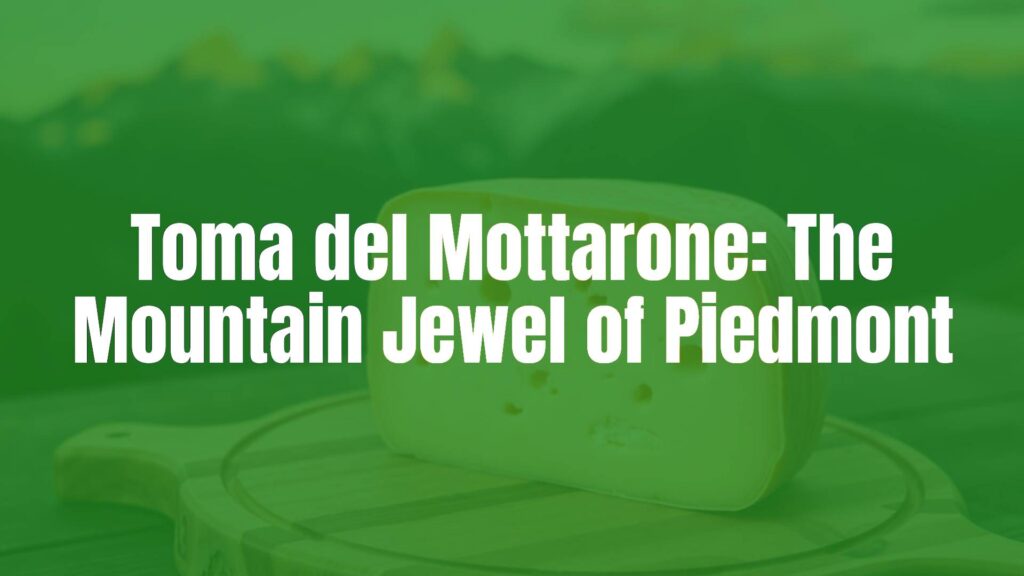An Introduction to Toma del Mottarone
Toma del Mottarone is a distinctive semi-hard cheese hailing from the picturesque alpine region surrounding Mount Mottarone, straddling the provinces of Piedmont and parts of Lombardy in northern Italy. Known for its rustic charm, subtle flavors, and centuries-old tradition, Toma del Mottarone is an outstanding example of the mountain cheeses that have shaped the culinary landscape of the region.
The Unique Traits of Toma del Mottarone
This cheese is easily recognized by its compact, thick cylindrical shape and a natural, straw-yellow to brown rind that speaks of time spent maturing in cool mountain cellars. The interior paste is supple yet elastic, with a pale ivory hue dotted occasionally by small eyes. Upon tasting, Toma del Mottarone presents mild, buttery notes with a gentle lactic tang and a faint aroma reminiscent of alpine grasses. It distinguishes itself with a delicate balance, making it appealing both for newcomers and aficionados of Italian cheeses.
Origins and Historical Roots
The story of Toma del Mottarone is closely entwined with the pastoral traditions of the Alps, where cheesemaking has long been an essential part of rural life. It is believed to have originated with mountain herders centuries ago, who sought to preserve fresh cow’s milk during the summer grazing season. The name “Toma” derives from the local dialect word for “cheese made by farmers,” and the style reflects a way of life deeply rooted in the highland communities around Mount Mottarone.
Traditional Production Methods
Toma del Mottarone is traditionally produced using whole or partially skimmed cow’s milk, often sourced from small local herds that graze on the lush alpine pastures. The milk is gently heated and curdled using natural rennet before the curds are carefully broken, drained, and placed into molds. Following a brief pressing, the wheels are salted and aged for periods that can span from one month to several, allowing flavors to evolve from sweet and milky to more pronounced and nutty. Authentic wheels are often matured in cool, humid caves, which help develop their characteristic rind and nuanced taste.
Cultural Significance and Local Enjoyment
Toma del Mottarone holds a special place in the hearts of Piedmontese mountain communities. It is more than just a food—it’s a symbol of agricultural resilience, artisanal skill, and regional pride. The cheese is celebrated at local festivals and fairs, often showcased alongside other alpine specialties. Traditionally, it is enjoyed with rustic bread, complemented by honey or nuts, and sometimes served as part of antipasto platters in the area’s mountain inns (trattorie).
Pairings and Serving Suggestions
Toma del Mottarone’s approachable character makes it a versatile table cheese. It pairs beautifully with young, fruity red wines from the region, such as a light Nebbiolo or a robust Barbera d’Alba. Its creamy texture also melds well with local acacia honey and orchard fruits. The cheese can be sliced into thick wedges and enjoyed simply or used to enhance polenta dishes, melted gently in savory tarts, or featured in mountain-style cheese boards with cured salumi and pickled vegetables.
Varieties and Modern Influence
While the essence of Toma del Mottarone remains unchanged, subtle variations exist between neighboring valleys, influenced by differences in flora, animal breeds, and cheesemaking techniques. Some modern artisans experiment with longer aging or new affinage techniques, creating wheels with more pronounced flavors or denser textures. These variations only add to the allure of a cheese that continues to evolve while honoring its alpine heritage.
Conclusion
Toma del Mottarone encapsulates the flavors and spirit of the Italian Alps in every bite. From its humble origins to its prominence on regional tables, it reveals the deep connection between landscape, tradition, and the enduring appeal of Italian artisan cheeses.

